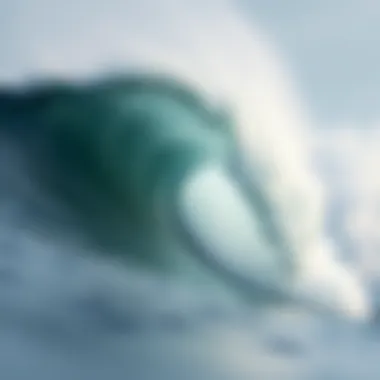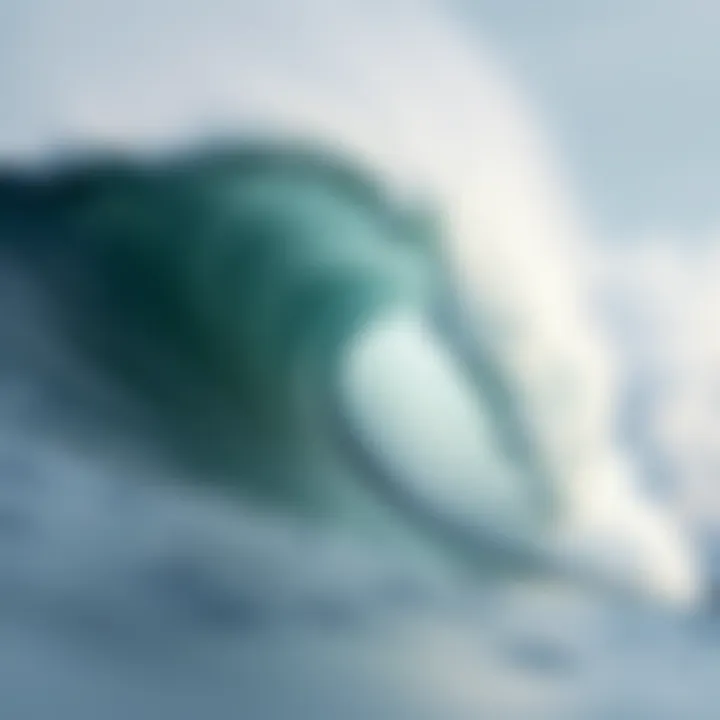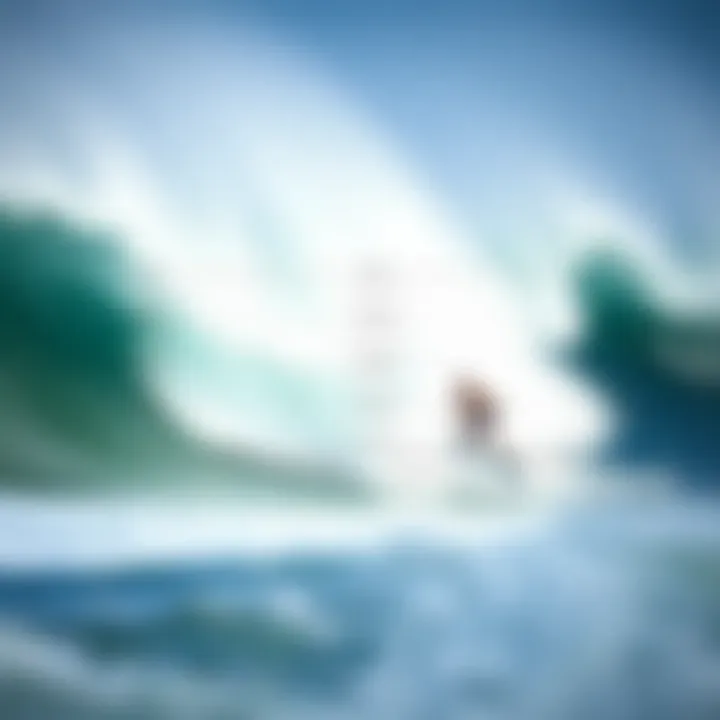Understanding Swell Charts for Better Surfing


Intro
In the exhilarating world of surfing, knowledge is as vital as skill when it comes to catching the perfect wave. At the heart of this knowledge lies the swell chart, an invaluable resource that helps surfers decipher the complexities of oceanic waves. Understanding these charts allows surfers, from novices to seasoned pros, to anticipate conditions, improve their performance, and enhance their overall surfing experience. This article embarks on an in-depth exploration of swell charts, breaking down their components, methods for data interpretation, and practical applications in the water.
Swell charts, at their core, display the generated wave patterns caused by wind, tides, and geographical variations. While the numbers might seem intimidating at first glance, they tell a story—a narrative of the ocean's behavior, waiting to be read. A comprehensive grasp of swell charts not only maximizes your time in the surf but also fosters a richer connection with the ocean. So, let’s dive in and unravel these pivotal tools that shape our ocean adventures.
Surfing Techniques
Mastering the Basics
To make full use of swell charts, you’ll want to get a handle on some foundational surfing techniques. This begins with understanding how to gauge wave height, period, and direction on the charts.
- Wave Height: Measured in feet, it indicates the size of the waves. Generally, bigger isn't always better; conditions, experience level, and local surroundings matter.
- Wave Period: The interval between waves. A longer period often means more powerful and better-quality waves.
- Wave Direction: Where the swell is coming from. This impacts how the waves break, dictating whether they’ll be gentle or more challenging.
Arming yourself with these basics will not only augment your ability to read swell charts but will also sharpen your instincts out on the water.
Advanced Maneuvers
Once you've nailed the fundamentals, you can explore advanced maneuvers made possible by the insights gleaned from swell charts. Knowing when to ride and where can turn an average day into an extraordinary one. Consider the following:
- Timing Your Session: Understanding the rise and fall of tide levels enhances your chances of finding those sweet spots where the waves perform best.
- Identifying Breaks: Each surf location has unique breaks. By studying swell charts, you can pinpoint which breaks will swell at specific conditions.
- Making Adjustments on the Fly: Real-time data adjustments can help you shift to another spot when the ocean serves up unexpected conditions.
"The right wave can make any surfer feel like a rock star; knowing how to read it is what gets you there."
Surfing Lifestyle
Sustainable Surfing Practices
In recent years, there has been a noteworthy shift in the surfing community toward sustainable practices. Understanding swell charts can guide surfers to locations where they can enjoy waves while having minimal impact on ecosystems.
- Choosing Local Spots: Favors shorter travel which cuts down carbon footprints.
- Using Eco-Friendly Gear: Opt for boards and wetsuits made from sustainable materials. Many brands now prioritize eco-conscious production.
- Educating Others: Share knowledge about swell charts and sustainable practices, thereby generating consciousness in the surfing community.
Surf Culture Around the World
The culture surrounding surfing is as diverse as the waves themselves. Each surf destination offers its own unique blend of tradition, lifestyle, and character influenced heavily by local swell patterns.
From the world-famous beaches of Malibu to the verdant coves of Bali, surfers engage through competitions, festivals, and communal gatherings. Recognizing swell patterns adds depth to these experiences, enhancing your appreciation for local surf cultures.
For those looking to immerse themselves further, resources like Wikipedia Surfing or Britannica offer helpful reading. Forums like Reddit Surfing and social platforms also serve as good venues to connect with fellow surfers and share experiences.
In summary, understanding swell charts does not just improve how you navigate the surf; it deepens your connection to a vibrant world of surfing that transcends mere sport. The ocean is ever-changing, and the ability to read it can transform your surfing expeditions into something resonant and enriching.
Foreword to Swell Charts
Swell charts play a vital role in understanding ocean waves and their conditions. For surfers, these charts are more than just numbers on a screen; they provide valuable insights that can elevate an ordinary experience into something extraordinary. Comprehending these charts can mean the difference between catching the perfect wave and facing the flat, disappointing stretches of water. As we embark on this exploration of swell charts, we grasp not only how to read them but also their significance within the broader tapestry of surfing.
What Are Swell Charts?
Swell charts are graphical representations that provide necessary data about sea swell conditions. They typically showcase key information including swell height, swell period, and swell direction. At first glance, they might appear to be just a jumble of lines and numbers, but for the trained eye, they reveal critical trends and forecasts. So, when you see a swell chart, think of it as your surf session's blueprint, guiding you to the best conditions based on predicted wave patterns.
Every swell chart is designed to give surfers a snapshot of what to expect at sea. They aggregate information from buoy data, satellite imagery, and weather patterns, painting a clearer picture of what the ocean waves will look like on any given day. Understanding these elements can empower surfers to plan their outings more effectively, ensuring a memorable day on the water.
Importance of Swell Charts in Surfing
Why should surfers pay attention to swell charts? The answer lies in the nuances between riding a wave and trying to paddle through unformed choppy water. The right swell can lead to smoother rides, better performance, and ultimately more enjoyment. Here are a few points to consider about their importance:
- Forecasting: Swell charts forecast upcoming conditions, allowing surfers to select the best times and locations to hit the waves. By knowing the swell's height and direction, surfers can pinpoint spots that work best with these factors.
- Safety: Knowledge is power, especially when it comes to ocean safety. A swell chart provides crucial information on wave conditions, allowing surfers to make informed decisions and avoid dangerous situations.
- Planning: For those planning surf trips, understanding swell charts is essential. It helps not just with timing but also with choosing the right destination. Some beaches are more favorable to certain swells, while others can be downright treacherous during specific conditions.
In summary, swell charts are indispensable tools for anyone serious about surfing. Their insights contribute to a more fulfilling, safe, and enjoyable surf experience, ultimately fostering a deeper connection with the ocean.
"A surfer's connection to the ocean is enhanced through knowledge, and swell charts are the keys to unlocking that mystique."
Understanding these charts transforms how surfers engage with the water, heightening both anticipation and appreciation with every wave.
Understanding the Basics


Understanding the intricacies of swell charts is crucial for surfers aiming to enhance their wave-riding experiences. At its core, this section delves into the fundamental terms and types of swells that dictate conditions out on the water. Knowing the basics can draw an insightful line between an average day at the beach and an epic surf session. In this context, we will discuss key terminologies and the various types of swells, offering a solid foundation for any surfer eager to master the art of swell chart interpretation.
Key Terminology
Swell Height
When it comes to swell height, it's all about the size of the waves you can expect. Swell height refers to the vertical distance from the trough of the wave to its peak. Higher swells often promise more thrilling rides, but they can also come with increased risks, particularly for less experienced surfers. Generally speaking, a swell height of around four to six feet is considered ideal for many surf spots. It strikes a balance—exciting enough to challenge, yet manageable for the average surfer. One unique characteristic of swell height is its variability based on geographical conditions, meaning one location may experience a radically different swell as opposed to another. Many surf forecasts will express swell height in feet, making it intuitive for surfers used to thinking in these terms.
Swell Period
Swell period is a standout factor determining how waves break, impacting surfing quality. It indicates the time, measured in seconds, between consecutive wave crests as they roll into shore. A longer swell period—typically over ten seconds—can mean that the waves have traveled long distances, resulting in more powerful and organized surf. Surfers often chase swells with longer periods because they tend to produce steep, hollow waves, ideal for tricks and maneuvers. Conversely, short-period swells lead to choppy and messy conditions. Therefore, understanding swell period not only maximizes potential success on the water but also provides crucial insights into the type of surf session to expect.
Swell Direction
The direction from which swells come can significantly affect wave conditions. Swell direction is typically expressed as a compass direction, such as "North" or "West." A south swell may work wonders at a specific point break, while a north swell may produce mushy waves, making them not so enjoyable. Knowing swell direction helps surfers choose the best location to catch quality waves and avoid crowded spots. Additionally, understanding how local geography influences swell direction means you can make smart decisions about where to paddle out.
Different Types of Swells
Ground Swells
Ground swells are what most surfers dream of. These swells propagate over long distances, typically generated by storms far out at sea, delivering smooth, rolling waves that are perfect for surf. Unlike their more chaotic counterparts, ground swells often maintain form and consistency, which is invaluable for maneuvers and tricks. However, timing is key; surfers need to know when ground swells arrive. Typically, they will become visible on charts days in advance.The downside? These swells can also become overhyped, leading to crowded lineups in popular spots. Acknowledge this uniqueness of ground swells, and you’ll find yourself part of discussions at local surf shops and shared between fellow surfers.
Wind Blown Swells
Wind-blown swells result from the local winds whipping up the sea surface. Unfortunately, they can be a mixed bag; while they can create fun, rideable waves, they often lack the consistency and power of ground swells. Wind swells can organize quickly and appear unexpectedly, inviting spontaneous surf sessions. However, they can also deliver bumpy, confused waves, particularly inshore. For beginner surfers, these swells might be ideal for practice, but they generally lack the predictability that seasoned surfers look for. Understanding wind-blown swells is essential—not only to catch waves when conditions are just right but also to appreciate the dynamic nature of ocean conditions.
"By grasping the basics, surfers can elevate their game and truly enhance their connection with the ocean."
In summary, knowing the key terminology and types of swells lays the groundwork for interpreting swell charts effectively. The relation between swell height, period, and direction provides a complete picture of what to expect out on the water. Armed with this foundational knowledge, surfers can make informed decisions, which ultimately enhances their experience.
Components of Swell Charts
Understanding the individual components of swell charts is essential for anyone looking to fine-tune their surfing experience. Each element serves a specific purpose and can drastically influence your time on the water. By familiarizing yourself with these components, you can not only make better decisions but also appreciate the complexity of the ocean and its behavior.
Reading Swell Height
Swell height indicates the vertical distance between the trough and the crest of a wave, and it's probably one of the first figures surfers look for. When monitoring conditions, understanding swell height can drastically alter your plans for a surf session. A reading of two to three feet might be just a gentle ripple for advanced surfers but could be intimidating for beginners.
Practical considerations come into play here; lighter or less experienced surfers often seek smaller swells, while seasoned riders may prefer heights of over six feet for a more thrilling ride.
To read swell height effectively:
- Focus on the units: Swell heights are usually measured in feet or meters. Understanding this metric is key.
- Watch for averages: Some charts give an average height alongside maximums. The average is often a more reliable indication of typical conditions you can expect during your session.
- Consider the location: Different surf spots react differently to swell heights. A three-foot wave at one beach might break painfully, while at another, it's a dreamy peel.
Interpreting Swell Period
Swell period refers to the time interval between consecutive waves, typically measured in seconds. A longer swell period indicates waves that have traveled greater distances and tend to be more powerful, while shorter periods usually mean choppy or disorganized waves.
Here's how the swell period can impact your sessions:
- Assess wave quality: Generally, swells with a period of 10 seconds or more are associated with cleaner, more organized waves. This is crucial for those looking to catch quality breaks.
- Anticipate energy levels: Higher energy waves are often associated with longer periods. If you’re keen on thrills, a forecast highlighting periods of 12-15 seconds means you might be in for a wild time.
- Plan for accordingly: Not all spots are suitable for all periods. A spot that favors short periods may not be fit for those longer swells, affecting your choice of locations.
Determining Swell Direction
Swell direction shows where the waves are coming from and profoundly affects how they break. It’s vital for surfers to know this as it greatly dictates the quality of the waves at their chosen surf break. Moreover, some beaches only work with specific swell directions, making it important to study this component closely.
Consider these key points:
- Swell charts typically mark direction in degrees: Surfers read this measure to know the wind direction and potential wave behavior. Directions like "northwest" or "southeast" can alter local surf conditions significantly.
- Local topography matters: A swell that comes from the southeast might create perfect waves at a point break while leaving a nearby beach with no action. Understanding your local area can guide you to the optimal conditions.
- Monitor wind influence: Winds often change the character of the swells. Cross-shore winds can add texture and make a wave fun, while side-shore winds may mess up a good swell.
“Knowing how to decode these charts can be the difference between an unforgettable day on the waves and an exercise in frustration.”
In summary, the components of swell charts work together to provide surfers with insights into wave conditions. By mastering reading swell height, interpreting swell period, and determining swell direction, surfers can navigate their sessions more confidently and safely.
Tools for Analyzing Swell Charts


To ride the waves that the ocean provides, it is crucial to have the right tools at your disposal. Analyzing swell charts is no small feat, but modern resources have made this task a lot easier. Understanding the tools available, whether you are planning a surf trip or trying to catch the best session, can greatly influence your time on the water. Additionally, knowing how to navigate these resources equips surfers with the knowledge they need to make smart decisions.
Online Resources
In today's digital age, online resources play an integral role in analyzing swell charts. Surf forecasting websites and mobile applications provide a wealth of information straight from the ocean.
Swell Forecasting Websites
Swell forecasting websites have become popular among surfing enthusiasts. They offer real-time data on swell conditions, wind patterns, and other factors impacting the waves. One of the standout features of these sites is the graphical representation of swell height and direction. This helps surfers visualize what they might encounter at their favored surf spots.
- Real-time updates: These websites track ocean conditions constantly, ensuring that surfers have the most accurate information.
- Interactive maps: Users can explore various surf spots, giving them insights into conditions in multiple locations.
- Forecast accuracy: Some sites, like Magicseaweed and Surfline, use advanced algorithms to predict swells, making them valuable resources for serious surfers.
However, it is worth noting that while forecasts provide a valuable guideline, conditions in the ocean are inherently unpredictable. It’s not uncommon for the charts to underestimate or overestimate wave heights based on changing weather systems.
Mobile Applications
In addition to websites, mobile applications have emerged as a vital tool for real-time swell analysis. Many surfers carry their smartphones everywhere, making apps a convenient and accessible option.
- User-friendly interfaces: Applications, like Windy and Surfline, provide easy navigation and quick access to swell information while on the go. Users can simply check their phones while at the beach to stay updated.
- Notification systems: Some apps allow surfers to set up alerts for specific conditions, ensuring they won’t miss out on optimal surf times.
- Offline mode functionality: This feature is particularly useful for surfers who might not always have consistent internet service while out in remote areas.
The downside, however, could be the battery drain from constant use or failure to deliver accurate information during high traffic times.
Local Surf Reports
Local surf reports provide another layer of information that can be very beneficial for surfers looking to spend time on the waves. These reports usually come from other surfers or surf schools and are often updated frequently.
- Community-driven: Many surf communities share local conditions through social media platforms like Facebook or Reddit. This can offer immediate, firsthand accounts of what’s happening at a specific beach, which is often more dynamic than general forecasts.
- Access to local knowledge: Regular surfers often have insights on the best times to surf, including hidden spots that may not be covered in larger forecasting websites.
It’s important to remember that local knowledge is invaluable. Engaging with local surf communities can provide insights not just about wave conditions, but also about surf etiquette, safety, and the unique characteristics of the local environment.
Practical Applications of Swell Charts
Understanding swell charts is not merely an academic exercise for enthusiasts; it directly influences the practical aspects of surfing. Surfers can harness this knowledge to maximize their time in the water and improve their overall experience. The following sections will illustrate the significance and benefits of applying swell chart insights to real-life surfing situations.
Planning Surf Trips
For many surfers, trips to the beach are not just casual outings, but carefully orchestrated experiences that hinge on wave conditions. Before packing up the surfboard and hitting the road, the use of swell charts becomes paramount. These charts provide critical data that helps you predict which beaches will offer the best surf conditions.
- Choosing Your Destination: By analyzing swell height, period, and direction, surfers can determine the ideal spots. For instance, a south-facing beach may be more favorable during a southwest swell than a northeast one. This simple check can lead to more enjoyable sessions.
- Timing is Key: Not all hours of the day are created equal. Swell charts can help identify peak times when conditions align perfectly with tides and wind patterns, ensuring that surfers catch the best waves rather than getting washed up on a flat day.
- Safety Considerations: Knowing when and where the swells hit allows surfers to avoid potentially dangerous conditions. A thorough understanding of swell charts can indicate whether to stay clear of rocky shores or crowded surf spots.
In essence, leveraging swell charts for planning surf trips can transform a recreational outing into a well-staged adventure with minimal surprise factors.
Optimizing Surf Sessions
Once at the beach, surf charts still hold relevance and can be used to finesse your sessions. Let’s break it down further:
- Fine-Tuned Strategy: Understanding how different swells work allows surfers to adapt their approach depending on real-time conditions. Are the waves breaking quickly? Adjust your paddling technique. Are they more mellow? Maybe it's time to practice some tricks.
- Equipment Choices: The swell height influences the type of board you might want to ride. Smaller swells may require a longboard for easier paddling, while bigger swells may call for a shortboard to handle the larger waves.
- Mindfulness in Motion: Keeping abreast of changes in the swell can foster a deeper connection with the ocean, enhancing your surfing experience. A keen surfer doesn't just ride the waves; they become part of the rhythm and flow of the water.
Utilizing this information, surfers can adapt their methods every session based on the swell charts and ensure their time on the water is both productive and exhilarating.
"Good surfers understand the ocean more than just a source of waves; it’s about respect and understanding what it offers in any given moment."
By embracing the practical applications of swell charts—from planning trips to optimizing sessions—surfers can elevate their connection to the sport and enhance their skill development.
Influence of Local Conditions
Understanding how local conditions influence swell is crucial for any surfer attempting to catch the best waves. The ocean is a complex system where various factors interact, affecting everything from wave height to shape. By analyzing local conditions, surfers can make well-informed decisions before hitting the water, ultimately enhancing their experience.
Tides and Their Interaction with Swell
Tides play a significant role in how swells behave once they reach the shore. Everyone knows that tides ebb and flow, but not everyone grasps the finer points of how they interact with incoming swells. Tides can change the depth of water over reefs and sandbars, leading to significant shifts in wave quality and size.
When swells roll in during high tide, the waves may become softer, offering a more forgiving ride. Conversely, during low tide, swells might break harder and steeper. Many seasoned surfers gravitate toward certain tides to synchronize with the swell for optimal performance.
Here are a few key points to consider about tides and their influence on swell:


- Timing: Surfing during rising tides can often provide smoother waves, which is beneficial for those looking to ride with style.
- Location: Tide behavior can vary significantly across geographic areas. A spot that works well during low tide might be a no-go during high tide.
- Environment: Some breaks, such as those over reef structures, rely heavily on the specific tides to create optimal wave conditions.
"Understanding the tide patterns not only enhances your surfing experience but can ultimately keep you safe in shifting wave conditions."
Wind Patterns Affecting Swell
Wind is another pivotal factor that interacts with swell, shaping how waves form and break. Contrary to what some may believe, the wind doesn’t just whip the surface into choppy conditions; it significantly contributes to wave creation. Wind-driven waves are a reality that surfers must navigate along with naturally formed swells.
Winds can come from several directions, creating a variety of surfing conditions:
- Offshore Winds: These winds blow toward the sea from the land, helping to hold up waves longer, making them cleaner and more surfable.
- Onshore Winds: Winds blowing from the sea toward the land can create more difficult conditions. They can steepen waves and lead to a choppy surface, making it less enjoyable for surfers.
- Cross-shore Winds: Depending on the break, cross-shore winds can sometimes create more favorable conditions, though they can also cause inconsistency in wave quality.
Local wind patterns can differ drastically by time of year and geographic location, representing another variable in the surfing equation. Surfers should always keep an eye on wind forecasts before heading out. For those who are serious about their surfing game, tools like local surf reports or reliable apps can aid in gauging wind direction and strength.
In summary, both tides and wind significantly impact how swells behave at surf spots. Understanding these local conditions will only sharpen skills in the ocean and deepen the bond surfers have with the unpredictable sea.
Common Misconceptions
When we dive into the world of swell charts, it’s essential to address some widespread misconceptions that often trip up even seasoned surfers. Understanding these misunderstandings can significantly enhance a surfer's experience, ensuring they are not just riding waves, but riding the right waves.
Size Doesn’t Always Equal Quality
One of the most common beliefs among surfers is the notion that bigger waves guarantee a better surfing experience. This, however, is a widespread misapprehension. Indeed, size does matter, but not in the way many might think.
- Wave Power: A larger swell can carry more energy, but that energy is not always translated into a rideable wave. Factors like wind conditions, tide levels, and the ocean floor topography play a critical role in determining how good a ride can be. A small, clean wave can often provide a more enjoyable session than a monstrous, choppy one.
- Wave Shape: Quality is determined by a combination of swell direction, wind speed, and local bathymetry. You can have a small, perfectly shaped wave that offers a thrilling ride, while a big wave that's messy and close out can be a nightmare.
Surfers should remember that having an eye for quality can often lead to the most exhilarating experiences, regardless of wave size. Knowing how to evaluate a wave's quality based on the swell chart can make all the difference.
Understanding Timeframes
Another prevalent misconception is the assumption that predicting swells is an exact science, one that can fit into specific timeframes. In reality, things are anything but straightforward.
- Forecast Accuracy: Swell charts provide estimations, but the ocean is a dynamic environment. A swell predicted to arrive in six hours may shift due to changing weather patterns or unforeseen wind changes. It’s a bit like waiting for the bus—sometimes it comes early, and sometimes it’s fashionably late.
- Wave Development: While swells can be forecasted up to several days in advance, their actual development and arrival will often vary. Timing a surf session often requires flexibility and a willingness to adapt to real-time conditions, which can change from minute to minute.
"The ocean has its own mind—timing is everything, but it won't always follow your schedule."
In taking timeframes with a pinch of salt, surfers can learn patience and develop a deeper respect for the ever-changing sea. Keeping an open mind about when the best conditions might arise can be beneficial. Surfing is not just a sport; it’s an exercise in adaptability and keen observation.
By understanding these misconceptions, surfers can better interpret swell charts and enjoy their time in the water to the fullest. Always remember, the best surf isn't just about the size or timing; it's about the journey with the waves.
For more insights on swell patterns and conditions, check resources like Surfline and research articles from National Oceanic and Atmospheric Administration.
End
Understanding swell charts is not just an academic exercise. For surfers, it means the difference between a mediocre session and an unforgettable ride. By diving into swell height, period, and direction, you equip yourself with valuable knowledge that contributes significantly to overall surfing experiences. The interplay of these variables can dictate whether a day on the water is exhilarating or disappointing.
In this article, we have traversed the essential facets of swell charts, shedding light on their core components while also exploring tools and considerations that can elevate one’s surf game. Whether you're a weekend warrior seeking the perfect wave after work or a seasoned pro on a quest to conquer new oceans, the importance of reading these charts can't be stressed enough.
Key elements laid out encompass:
- The definition and purpose of swell charts
- The terminology key to understanding ocean waves
- The interpretation of crucial metrics such as height and period
- The influence of local conditions on wave quality
- Common misconceptions that can hinder surfers from making the most of the charts
Equipping yourself with this information not only enhances your own understanding but also fosters a deeper connection to the environment. Embracing these insights can lead to improved decision-making, which is vital for both safety and enjoyment out on the water.
Ultimately, the ocean is as unpredictable as it is beautiful. By taking the time to continuously learn and adapt your understanding of swell charts, you set yourself up for success. Staying informed keeps you ahead of the curve and perpetually ready for that once-in-a-lifetime wave.
Summary of Key Points
To wrap things up, here’s a recap of what we’ve covered regarding swell charts and their significance in surfing:
- Swell height, period, and direction are the primary metrics to analyze.
- Each of these metrics contributes to how waves break and their overall surfability.
- Local conditions, such as wind and tides, also play a significant role, often altering what the charts predict.
- Misunderstanding various aspects of swell charts can lead to misguided expectations, emphasizing the need for clear comprehension.
By grasping these points, you not only enhance your surfing skills but also develop a nuanced appreciation for the complexities of ocean waves.
Encouragement for Continuous Learning
The world of surfing is in constant flux, and so is your understanding of it. As surf culture matures and technology evolves, there are always new techniques, tools, and resources emerging that can enhance your prowess. Engage with local surf communities, participate in workshops, and explore online forums like reddit.com/r/surfing or facebook.com/groups/surfers where you can exchange knowledge and experiences.
Take the time to regularly check reliable resources that delve into swell forecasts, such as magicseaweed.com and surfline.com. These platforms not only track swell activity but can also guide you in making smart choices for your next session. Learning about changes in tide patterns or variations in swell direction ensures that you're not only prepared but also adaptable.
Don’t shy away from experimenting with new spots or techniques when reading your swell charts. Take notes on your experiences; perhaps you’ll stumble on insights that the charts won’t tell you directly. The more you put into learning, the more rewarding your surfing journey will become. The ocean is a classroom in itself, so stay curious and keep riding those waves.















